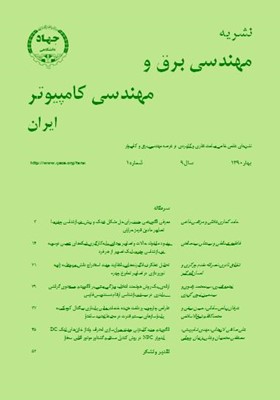معرفي الگوريتمي جديد براي حل مشكل عينك و ریش در بازشناسی چهره با تصاویر مادون قرمز حرارتی
محورهای موضوعی : مهندسی برق و کامپیوترحامد کماری علائی 1 * , مرتضی خادمی 2
1 - دانشگاه فردوسی مشهد
2 - دانشگاه فردوسی مشهد
کلید واژه: بازشناسی چهره تصاویر مادون قرمز حرارتی رگهای صورت الگوریتم تطبیق زمانی پویا,
چکیده مقاله :
بازشناسی چهره از طریق تصاویر مادون قرمز حرارتی یکی از جدیدترین راهکارهای بازشناسی چهره بوده و هماکنون مورد توجه بسیاری از محققان میباشد. این شناسایی که از طریق ثبت توزیع حرارتی چهره و چگونگی موقعیت رگهای صورت انسان انجام میشود دارای مزیتهای بسیاری نسبت به روشهای مبتنی بر تصاویر بینایی متداول میباشد. در این تصاویر اثر تغییرات نور محیط که یکی از مهمترین معضلات بازشناسی چهره در تصاویر حوزه بینایی است، مرتفع میشود. یکی از مهمترین مشکلات بازشناسی چهره در تصاویر مادون قرمز حرارتی وجود موانع انتشار مانند عینک و ریش بوده که مانع استخراج دقیق موقعیت رگهای صورت میگردند. در اين تحقیق براي اولین بار الگوریتمي پیشنهاد شده است كه این مشکلات نیز تا حد زیادی برطرف ميگردند. در این مقاله جهت استخراج ویژگی صورت از موقعیت انشعاب رگها استفاده شده است و همچنین با انتخاب دستهبندی مناسب، رگهای تقلبی و انشعابات نادرست حذف شدهاند. از طرفی با استفاده از الگوریتم تطبیق زمانی پویا بهترین بردارهای ویژگی استخراج میشوند. با بررسی نتایج شبیهسازی شده بر روی بانک داده UTK-IRIS نرخ شناسایی بر روی تصاویر با عینک 95٪ و بر روي تصاوير با ریش صورت 88% است که نسبت به بهترين نتایج بهدست آمده قبلی در بانک داده یکسان، بهترتيب 10٪ و 40% بهتر میباشند.
Face recognition via thermal infrared images is a modern recognition method. It has been so interesting for many researchers during last ten years. This method which operates via thermal features and the situation of human face vessels has much more benefits than visual-based methods. In these images, the effect of environmental lights changes, which is one of the most important obstacles of face recognition via visual images, is totally eliminated. The most important face recognition problem via thermal infrared images is the existence of diffusion obstacles like glasses and beard, which block the exact extraction of the situation of face vessels. Considering the suggested algorithm, these problems have been completely solved. In this paper face recognition is done through face vessels. For extraction of the face features, the situation of vessel branches is used. Also by choosing appropriate classification, fake vessels and false branches has been omitted. On the other hand, the best feature is extracted by using Dynamic Time Wrapping algorithm which is resistant to nonlinear changes. The simulation on UTK-IRIS gallery set has showed the accurate recognition rate 95% on the images with glasses and 88% on the images with beard, so the proposed method has improved the recognition rate about 10% and 44% respectively on same gallery set compared with the best other works.
[1] A. Jain, R. Bolle, S. Pankanti, and A. K. Jain, Biometrics: Personal Identification in Networked Society, Kluwer Academic Publishers, 1999.
[2] W. Zhao, R. Chellapa, P. J. Phillips, and A. Rosenfeld, Face Recognition: a Literature Survey, ACM Computing Surveys (CSUR), p. 399, 2003.
[3] Z. L. Stan and K. J. Anil, Handbook of Face Recognition, Springer Science, 2005.
[4] D. Socolinsky, L. Wolff, J. Neuheiser, and C. Evelenad, "Illumination invariant face recognition using thermal infrared imagery," in Proc. of the IEEE Computer Society Conf. on Computer Vision and Pattern Recognition, vol. 1, pp. I-527 - I-534, Kauai, Hawaii, US, 8-14 Dec. 2001.
[5] P. Buddharaju, I. T. Pavlidis, P. Tsiamyrtzis, and M. Bazakos, "Physiology-based face recognition in the thermal infrared spectrum," IEEE Trans. on Pattern Analysis and Machine Intelligence, vol. 29, no. 4, pp. 613-626, Apr. 2007.
[6] F. J. Prokoski and R. Riedel, "Infrared identification of faces and body parts," Biometrics: Personal Identification in Networked Society, A. K. Jain, R. Bolle, and S. Pankati, eds., Chapter 9. Kluwer Academic, 1998.
[7] F. Dellaert. The Expectation Maximization Algorithm, Technical. Report GIT- GVU-02-20, College of Computing, Georgia Institute of Technology, Feb. 2002.
[8] D. Maltoni, D. Maio, A. K. Jain, and S. Prabhakar, Handbook of Fingerprint Recognition, Springer Verlag, Jun. 2003.
[9] P. Buddharaju and I. Pavlidis, "Physiological face recognition is coming of age," in Proc. IEEE Conf. on Computer Vision and Pattern Recognition, CVPR'09, Miami, FL, US, Jun. 2009.
[10] E. Keogh and M. Pazzani, "Derivative dynamic time warping," in Proc. First SIAM Int. Conf. on Data Mining, SDM'01, Chicago, US, 5-7 Apr. 2001.
[11] M. Turk and A. Pentland, "Eigenfaces for Recognition," J. of Cognitive Neuroscience, vol. 3, no. 1, pp. 71-86, Winter 1991.
[12] T. Fawcett, "An introduction to ROC analysis," Pattern Recognition Letters, vol. 27, no. 8, pp. 861-874, Jun. 2006.
[13] S. G. Kong, J. Heo, F. Boughorbel, Y. Zheng, B. Abidi, A. Koschan, M. Yi, and M. Abidi, "Adaptive fusion of visual and thermal IR
images for illumination-invariant face recognition," Int. J. of Computer Vision, vol. 71, no. 2, pp. 215-233, Feb. 2007.

